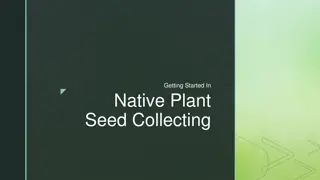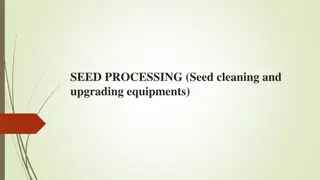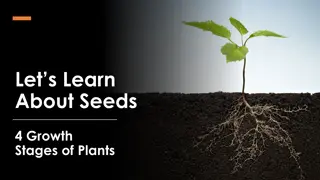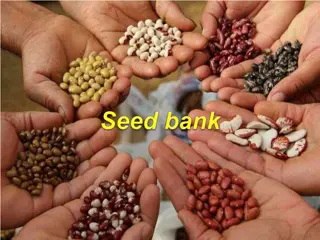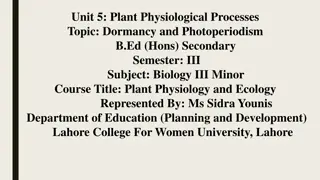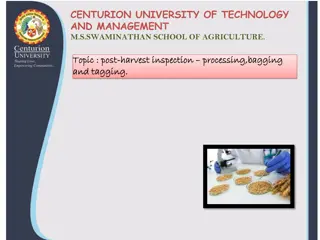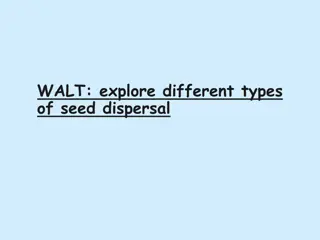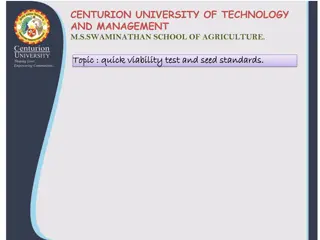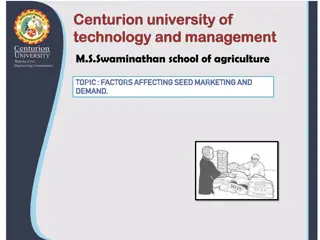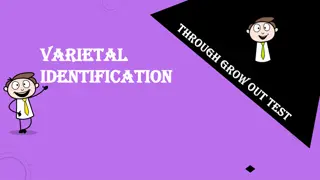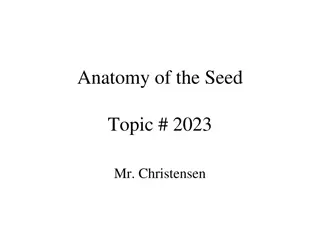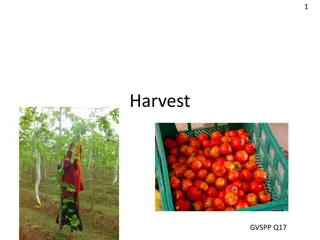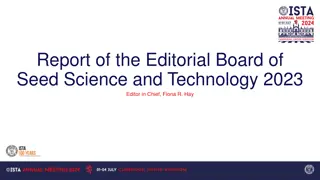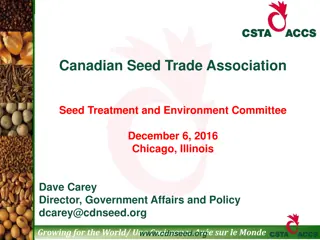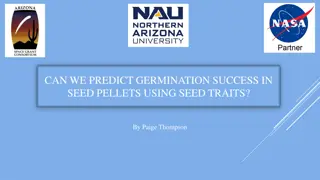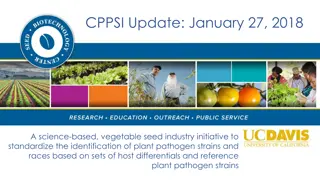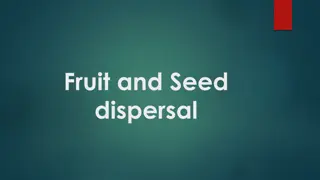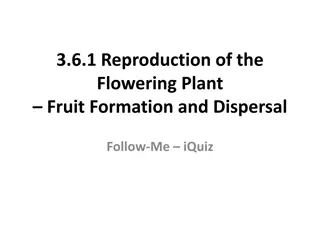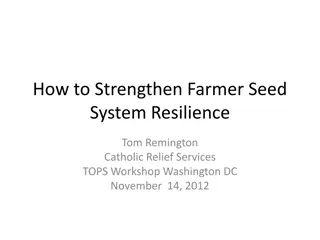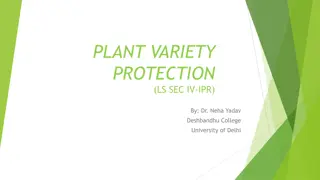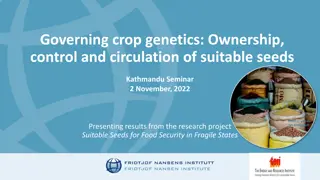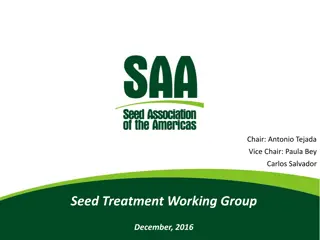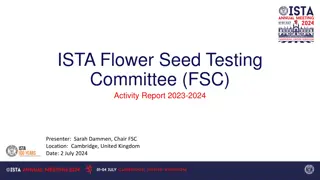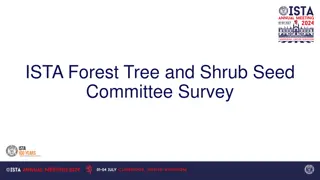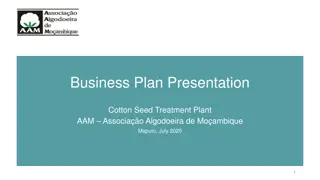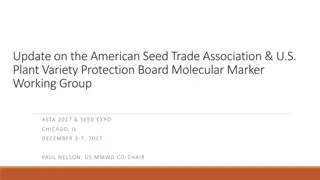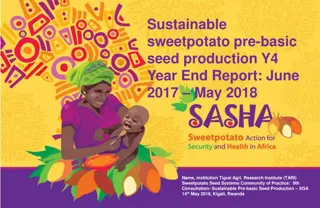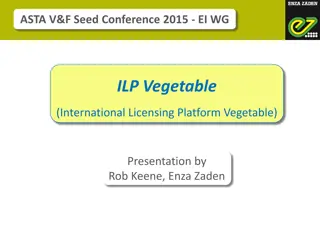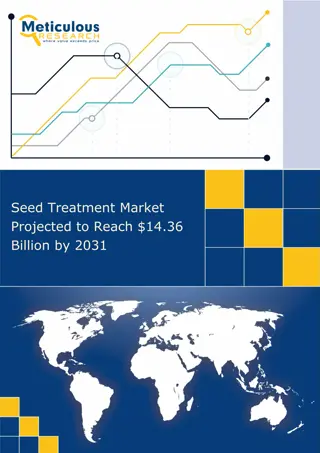Exploring Seed Plant Diversity and Adaptations
Delve into the realm of seed plants, uncovering their unique adaptations for reproduction, their phylogeny with gymnosperms and angiosperms, and the diversity within gymnosperms such as conifers, cycads, gingkophytes, and gnetophytes. Discover the evolutionary success of seed plants through their wa
5 views • 23 slides
Seed Treatment Market to Reach $14.36 Billion by 2031
Seed Treatment Market by Type (Chemical {Insecticides}, Biological), Form (Liquid, Dry), Function (Seed Protection, Seed Enhancement), Application Technique (Seed Coating, Seed Dressing), Crop Type (Cereals & Grains, Oilseeds) - Global Forecast to 2031\u2019
2 views • 5 slides
Native Plant Seed Collection: A Guide to Conservation and Sustainability
Explore the valuable practice of collecting native plant seeds to preserve biodiversity, restore ecosystems, and promote sustainable land management. Learn about seed collection ethics, when to collect seeds, and seed germination methods for various species.
0 views • 15 slides
Efficient Layout Planning for Seed Processing Plant
Seed processing is crucial for removing contaminants and drying seeds to a safe moisture level. Planning a seed processing plant layout involves considering factors like types of seeds, operation size, equipment selection, location, labor availability, and more. Components of the building layout inc
2 views • 25 slides
Understanding the 4 Growth Stages of Plants from Seed to Adult Plant
Explore the fascinating journey of a plant's life cycle through its 4 growth stages: Seed, Germination, Seedling, and Adult Plant. Discover what seeds need to grow and what each stage requires for survival and growth. Engage in a hands-on activity to rearrange the plant growth stages and learn about
0 views • 9 slides
Understanding Plant Embryogenesis: A Comprehensive Overview
Plant embryogenesis is a crucial process in the development of plant embryos from fertilized ovules, involving cell division, differentiation, and morphogenesis. This process leads to the formation of seeds, which play a vital role in the plant life cycle. The stages of embryo formation, structure,
0 views • 25 slides
Understanding the Importance of Seed Banks in Ecosystems
Seed banks, categorized into soil and aerial types, serve as essential reservoirs for viable seeds and propagules. Soil seed banks are natural storage areas for seeds within ecosystems and play a crucial role in plant regeneration. They can persist for varying durations, influencing plant diversity
1 views • 16 slides
Understanding Plant Hormones and Their Functions in Plants
Plant hormones play crucial roles in various plant processes such as growth, development, and response to environmental stimuli. Auxins, gibberellins, and abscisic acid are key plant hormones that regulate tropisms, cell division, elongation, flowering, seed germination, and dormancy. Understanding
1 views • 50 slides
Understanding Seed Dormancy and Ways to Break it
Seed dormancy is a crucial aspect of plant growth, where seeds remain inactive and do not germinate even under favorable conditions. Various reasons contribute to seed dormancy, such as light, temperature, and hard seed coats. Different types of dormancy like innate, enforced, and induced are explai
1 views • 9 slides
Understanding Plant Tissue Culture Media and Their Importance in In Vitro Growth
Plant tissue culture media play a crucial role in the in vitro growth and morphogenesis of plant tissues. The composition of culture media depends on the specific plant species and the type of material used for culture. Various types of media, such as White's medium, MS medium, B5 medium, N6 medium,
0 views • 6 slides
Seed Post-Harvest Inspection and Processing Guidelines
The post-harvest inspection and processing of seed crops involve various crucial steps from pre-cleaning to seed treatment, bagging, and storage. Following specific prerequisites ensures the quality of the final seed lot. Inspection during processing and seed sorting in different crops is essential
1 views • 8 slides
Understanding Seed Dispersal in Flowering Plants
Explore the fascinating world of seed dispersal in flowering plants, from wind dispersal to bursting pods and shaking mechanisms. Discover the various methods plants use to spread their seeds and ensure their survival. Dive into the stages of a flowering plant's life cycle and learn how germination,
1 views • 16 slides
Understanding Seed Viability Testing and Standards
Seed viability is crucial for successful germination and plant growth. Various tests like tetrazolium, germination, cut, X-ray analysis, and more are used to assess seed viability. Preconditioning seeds, seed hydration, and seed staining are important steps in the tetrazolium test. Evaluating seeds
0 views • 8 slides
Factors Affecting Seed Marketing and Demand in Agriculture Sector
Factors affecting seed marketing include clear-cut policy, availability of adapted varieties, production and storage facilities, official programs, and demand forecasting. Components such as cropping patterns, climate, market situation, and farm income levels influence seed demand. Effective demand
5 views • 7 slides
Understanding Plant Pathology: Importance, Scope, and Objectives
Plant pathology, also known as phytopathology, is the study of plant diseases and their management. It covers the causes, symptoms, and impact of pathogenic organisms on plants. The field aims to understand the interactions between plants and pathogens, develop control methods, and reduce losses in
0 views • 6 slides
Understanding Grow-Out Test for Genetic Purity Evaluation in Seed Certification
The Grow-Out Test is a crucial measure in seed certification to determine the genetic purity of seed lots. It helps in controlling genetic contaminations and ensuring compliance with prescribed standards. This test is essential for certain species like cotton, castor, musk melon, and brinjal in Indi
0 views • 16 slides
Introduction to Plant Physiology: Exploring the Functioning of Plants
Plant physiology is a crucial subdiscipline of botany that delves into the processes and functions operating within plants. This field closely examines areas like plant morphology, ecology, cell biology, and genetics, shedding light on vital processes such as photosynthesis, respiration, and more. T
1 views • 7 slides
Understanding Seed Anatomy and Germination Processes
Explore the anatomy of seeds, including taxonomic classes like angiosperms and gymnosperms, subclasses within angiosperms, and components of a seed such as the embryo, endosperm, and seed coat. Learn about seed germination conditions, dormancy, and factors like favorable temperature and scarificatio
0 views • 17 slides
Understanding Plant Tissue Culture: Techniques and Applications
Plant tissue culture involves maintaining and growing plant cells, tissues, or organs in artificial mediums under controlled conditions. It allows the regeneration of whole plants from small plant parts or cells. Hormones like auxins, cytokinins, and gibberellins are used in the process. Proper envi
3 views • 5 slides
Harvesting and Postharvest Techniques for Quality Seed Production
Understand the importance of harvesting crops at the right timing to maximize seed quality. Learn about half-matured and full-matured stages, postharvest ripening, and indicators for precise timing. Discover the significance of counting days from flowering/pollination for determining harvest timing.
0 views • 24 slides
Challenges and Innovations in Seed Science Publishing
Seed Science and Technology (SST) is an international journal focusing on seed quality and physiology. The journal, established in 1973, covers various aspects of seed production, testing, storage, and genetic conservation. Special issues like the 50th volume celebrate advancements in seed viability
0 views • 9 slides
Canadian Seed Trade Association Overview and Regulations
The Canadian Seed Trade Association (CSTA) plays a vital role in seed innovation and trade, focusing on open trade, increased investment in innovation, and industry-wide voice. The association follows specific regulations in Ontario related to neonicotinoids and pesticides. These regulations are dri
0 views • 26 slides
Plant Tissue Culture Methods for Growth and Reproduction Study
Plant tissue culture methods such as root tip culture, shoot-tip culture, leaf culture, flower culture, and anther and pollen culture allow for the study of growth, reproduction, and genetic variations in plants. These techniques involve culturing various plant parts under sterile conditions to inve
1 views • 20 slides
Understanding Plant Quarantine and Phytosanitary Measures
Plant quarantine involves efforts to prevent the entry, establishment, or spread of foreign pests through legal restrictions on plant and plant product movement. It is crucial for safeguarding plant health, food production, and ecosystems. Phytosanitary measures aim to ensure the health of plants by
0 views • 33 slides
Enhancing Restoration Success with Seed Pellets: A Study on Predicting Germination in Arid Environments
Ecological restoration in arid lands often faces challenges with seeding projects. This study explores using seed pellets to predict germination success by matching seed traits with pellet characteristics. The hypotheses focus on seed size and species comparison to improve restoration practices.
0 views • 13 slides
Understanding Dormancy in Plants: Causes and Implications
Dormancy in plants, involving seeds and buds, is a state where growth is temporarily halted due to internal or external factors. Factors like immature embryos, impermeable seed coats, and growth inhibitors contribute to seed dormancy. The presence of inhibitors like abscisic acid and the influence o
0 views • 43 slides
Standardizing Identification of Plant Pathogen Strains in Vegetable Seed Industry
Focused on standardizing plant pathogen strain identification, the CPPSI initiative by UC Davis works towards enhancing the industry's capabilities. Through reference materials and strategic collaborations, CPPSI aims to streamline disease management processes and promote sustainability. The project
0 views • 8 slides
Plant Reproduction: Pollination and Seed Dispersal Mechanisms
Explore the fascinating world of plant reproduction through pollination and seed dispersal mechanisms. Learn about the different types of pollination, such as self-pollination and cross-pollination, and the importance of fruit and seed dispersal. Discover how plants use various strategies to ensure
0 views • 6 slides
Reproduction of Flowering Plants: Seed Development and Endospermic Seeds
The quiz content discusses the process of seed development in flowering plants, focusing on the formation and dispersal of fruits. It touches upon the different parts of a seed, such as the seed leaf, food store, ovule, and endosperm, highlighting their roles in the growth of new plants. Additionall
0 views • 50 slides
Strengthening Farmer Seed System Resilience Workshop Insights
Explore key insights from the TOPS workshop on strengthening farmer seed system resilience, focusing on seed security, resilience parameters, and the connection between shocks/stresses and farmer seed systems.
0 views • 22 slides
Overview of Plant Variety Protection and International Treaties
Plant variety protection is essential for biodiversity and sustainable agriculture. Various international conventions and treaties such as CBD, UPOV, and TRIPs impact the legal framework for protecting plant varieties. The UPOV organization aims to safeguard plant breeders' rights separately from pa
0 views • 21 slides
Exploring Seed Governance and Crop Genetics for Food Security
Diving into the dynamics of seed ownership, control, and circulation for sustainable agriculture and food security in fragile states, this research project sheds light on the impacts of regulated germplasm exchange and seeds legislation. Discussing themes such as diversity in plant breeding, interna
0 views • 31 slides
Seed Treatment Working Group Overview in the Americas
The Seed Treatment Working Group (STWG) in the Americas focuses on facilitating treated seed trade, promoting safe seed technology use, and collaborating with regulatory agencies. Activities include identifying regulatory agencies, educational materials translation, and regulatory mapping. Updates f
0 views • 14 slides
ISTA Flower Seed Testing Committee Activity Report 2023-2024
The ISTA Flower Seed Testing Committee, led by Sarah Dammen, presented their activities in 2023-2024 in Cambridge, UK. The committee discussed testing procedures for various flower species, initiated new projects, and worked on updating the ISTA Handbook on Flower Seed Testing. Proficiency tests, wo
0 views • 7 slides
Overview of Forest and Shrub Seed Testing Committee Activities
This document provides valuable insights into the activities of the ISTA Forest Tree and Shrub Seed Committee, including information on tested species, laboratory processes, and contributions to the seed trade. It outlines key questions posed to laboratories, details the most tested species, and hig
0 views • 17 slides
Enhancing Cotton Seed Quality for Sustainable Growth in Mozambique
The cotton subsector in Mozambique has significant potential but faces challenges due to the poor quality of seeds. AAM aims to improve cotton seed quality by establishing a seed treatment plant, benefiting farmers and ginners alike. The project, divided into inception and operational phases, promis
0 views • 59 slides
Advancements in Molecular Marker Utilization for Plant Breeding
Explore the latest developments in using DNA markers for plant breeding, focusing on applications such as marker-trait association, germplasm characterization, and seed purity. Learn how DNA markers are revolutionizing plant science by enhancing genomic prediction, facilitating varietal distinctness
0 views • 9 slides
Sustainable Sweetpotato Pre-basic Seed Production Y4 Year-End Report
Tigrai Agri. Research Institute (TARI) presented a comprehensive report on the sustainable production of pre-basic sweetpotato seeds in Year 4, ending in May 2018. The report covers production capacities, targets vs. actuals, actions taken to increase multiplication rates and reduce production costs
0 views • 13 slides
ASTA.V&F Seed Conference 2015 - EI WG: Advancing Global Access to Plant Breeding Traits
The ASTA.V&F Seed Conference 2015 - EI WG focused on the launch of the International Licensing Platform Vegetable (ILP Vegetable) to enhance global accessibility to plant breeding traits. Discussions revolved around patents' impact on innovation, with 11 prominent companies collaborating to establis
0 views • 18 slides
Global Seed Treatment Market to Hit $14.36 Billion by 2031 Amid Growing Agricult
Seed Treatment Market by Type (Chemical {Insecticides}, Biological), Form (Liquid, Dry), Function (Seed Protection, Seed Enhancement), Application Technique (Seed Coating, Seed Dressing), Crop Type (Cereals & Grains, Oilseeds) - Global Forecast to 20
1 views • 4 slides


